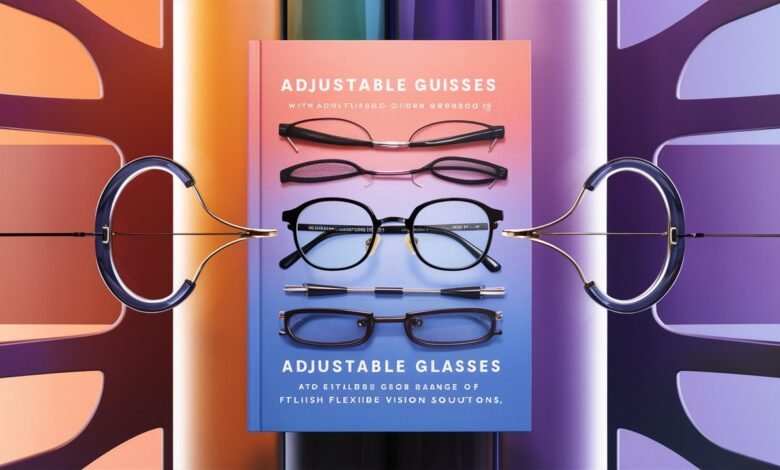Adjustable Glasses Review: A Comprehensive Guide to Flexible Vision Solutions

Introduction
Adjustable glasses, also known as variable-focus or multi-user spectacles, have emerged as a versatile alternative to traditional prescription eyewear. Designed to correct vision dynamically via manual adjustments, these glasses cater to individuals with presbyopia, myopia, or hyperopia, offering a temporary or emergency solution for fluctuating vision needs. This review explores their mechanics, benefits, limitations, and real-world performance, drawing insights from user experiences, technical specifications, and expert evaluations 1611.
How Do Adjustable Glasses Work?
Adjustable glasses utilize innovative lens technologies to modify their optical power. Two primary mechanisms dominate the market:
- Fluid-Filled Lenses: Brands like Adlens employ syringes or dials on the frame arms to pump fluid into flexible lens membranes, altering their curvature and refractive power. Increasing fluid corrects farsightedness (+3D), while decreasing it addresses nearsightedness (-6D) 111.
- Sliding Lens Systems: Eyejusters and Dial Vision use dual polycarbonate plates that slide across each other via knobs, adjusting focal length for tasks like reading or screen use. This “Alvarez Dual Lens” system allows customization from +0.50D to +4.00D 611.
These systems eliminate the need for multiple prescription pairs, though they lack correction for astigmatism and require manual calibration 12.
Pros and Cons of Adjustable Glasses
Advantages
- Cost-Effective: Priced between
- 10–
- 10–50, they’re cheaper than progressive lenses or bifocals, making them ideal for backup use 610.
- Versatility: Suitable for near, intermediate, and distance vision, with individual eye adjustments for asymmetrical prescriptions 311.
- Emergency Readiness: Lightweight and shareable, they’re practical for households, travel, or outdoor activities like camping 110.
Limitations
- Bulkiness and Aesthetics: Frames often feature prominent dials or fluid chambers, compromising style. Users describe them as “goofy-looking” or “weird” 13.
- Limited Precision: Adjustments may not match prescription accuracy, leading to eye strain. The field of view is narrower, making them unsuitable for driving 16.
- Durability Concerns: Cheap models (e.g., Amazon’s EXGYAN) use flimsy plastic prone to breakage, with lenses scratching easily 35.
Top Adjustable Glasses Brands Reviewed
- Adlens Adjustables
- Range: -6D to +3D correction via fluid-filled lenses.
- Use Case: Emergency spares or post-surgery recovery. Users praise their practicality but note limited aesthetics 111.
- Eyejusters
- Features: Hidden dials for +0.50D to +4.00D, scratch-resistant lenses, and unisex designs. Ideal for presbyopia management 611.
- Dial Vision
- Affordability: Budget-friendly ($25 average) with individual lens adjustments. Mixed reviews cite difficulty achieving clarity 610.
- Varifocus
- Mid-Range Option: Priced at ~$50, marketed for outdoor enthusiasts. Limited availability and reports of dirt accumulation in mechanisms 10.
User Experiences and Practical Applications
Everyday Use
While adjustable glasses work for reading or screen time, users report challenges in fine-tuning. A 93-year-old tester found them usable after assistance, but others struggled with shaky hands or unintuitive dials 110.
Outdoor and Emergency Scenarios
Campers and hikers appreciate their portability, though cheap models often fail in rugged conditions. One user noted their utility for locating lost glasses but deemed them unreliable for prolonged use 10.
Humanitarian Efforts
Nonprofits like the Centre for Vision in the Developing World distribute Adspecs glasses, which correct refractive errors in low-resource areas. Over 100,000 pairs have been deployed globally 11.
Frequently Asked Questions (FAQs)
- Can adjustable glasses replace my prescription eyewear?
No. They lack precision for astigmatism or complex prescriptions and are best as temporary solutions 16. - Are they safe for driving?
Unlikely. The narrow field of view and calibration challenges pose risks. Stick to prescription lenses for driving 16. - How durable are adjustable glasses?
High-end brands (Adlens, Eyejusters) use sturdy materials, but budget options often break within weeks 311. - Do they work for children?
Some models are marketed for experiments, but optometrists recommend proper prescriptions for developing eyes 37. - What’s the average cost?
10–
10–50 for non-prescription models. Prescription inserts may raise prices 610.
Conclusion
Adjustable glasses offer a innovative yet imperfect solution for dynamic vision needs. While they excel as emergency backups or humanitarian tools, their limitations in aesthetics, precision, and durability make them unsuitable for primary use. For optimal results, pair them with regular eye exams and high-quality prescription eyewear. As technology advances, future iterations may bridge the gap between convenience and clinical accuracy, revolutionizing accessible vision care.
Sources Cited: [Adlens]1, [Family Optometric]2, [Amazon Reviews]35, [Vision Center]6, [All About Vision]11.



